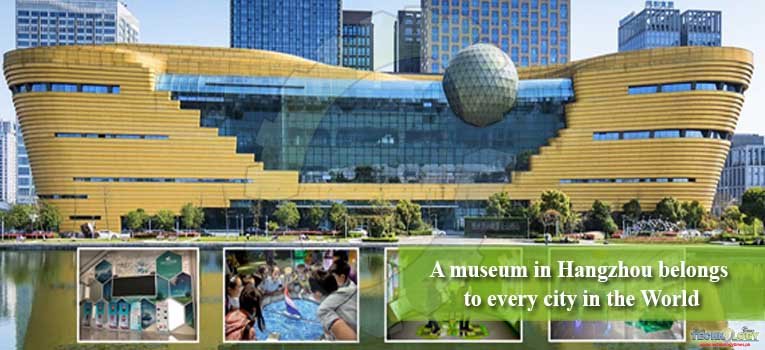It is quite often when you visit somewhere and think that it should exist everywhere in the world. The Low Carbon Science and Technology Museum in Hangzhou is such a place like this.
 The Museum opened in July 2012, it’s four story building covering 16,718 square meters of exhibition and auditorium space. The displays hanging from the ceiling in the glass-covered main lobby are large-scale chemical-composition replicas of greenhouse gasses.
The Museum opened in July 2012, it’s four story building covering 16,718 square meters of exhibition and auditorium space. The displays hanging from the ceiling in the glass-covered main lobby are large-scale chemical-composition replicas of greenhouse gasses.
The displays on the lobby floor are models of low-energy products. In the sides of the museum are various interactive presentations, diorama, exhibits, games, and rides designed to educate visitors about green living, climate change, and green technologies.
Lobby of Low Carbon Museum projects the theme of “low carbon life, for our future” to the visitors in the form of vibrant models, images, and videos, with high-tech aptitude support, and motivate visitors to discover more about the museum.
It is divided into five exhibition areas: scientific exploration base, through the jungle, pastoral adventure, fun of the pond and low-carbon laboratory. Here you can learn basic science knowledge of environmental science, mechanics, optics and biology, and improve your insight, imagination and creativity.
There are several exhibitions in Low Carbon Museum. The climate change exhibition ride is especially striking. It is an impressive experience area with various modern technological and artistic presentations techniques.
Here visitors will take the bamboo raft and experience the six thematic exhibitions of the beautiful home the West Lake, urban sprawl, glacier melting, the burning earth, extreme weathers and the XiXi Wetlands in turn, which shows the shocking scenes in extreme environments caused by global warming.
For visiting this exhibition there is a rectangular vehicle constructed with bamboo along with 3D glasses for visitors. This vehicle took visitors to several rooms in which they watched 3D movies and experienced post-3D effects such as heat, cold, and vibrations.
The first room is pristine wetlands, the second is fast-forward of civilizations from primitive huts to metropolis, the third one is melting ice caps with sad polar bears, the fourth is clear-cutting in rainforests, drought and forest fires, the fifth is catastrophic flooding in a major city, and the sixth is flash-freezes and blizzards completely disabling a city.
Carbon Circulation is the second exhibit reveals the secrets of carbon through the four parts of carbon on the earth, carbon cycle in nature, how humans use carbon and the impact of human activities on carbon cycle.
In the display of the old doctor’s study, there is a dynamic and static image of the old doctor which introduces knowledge of carbon nanotube through attractive stories.
The electronic games on another level are another fun and engaging. One interactive game made the player plant different vegetation by stepping on DDR-esque squares to offset the falling CO2 ‘bombs’ i.e. if ‘92’ is falling the player has to offset it with 1 tree for ‘60’ and 1 bamboo for ‘32’ before it hits the ground.
Another game in which player earn points by sorting falling trash into ‘organic waste,’ ‘hazardous waste,’ ‘recyclable,’ and ‘other’ by pressing on large colorfully illuminated buttons before the trash hit the ground.
Similarly, there is a low carbon city exhibit, low carbon science and technology exhibit which are much more science-oriented and are extremely informative even for children which introduces the scientific techniques based on which the low-carbon green lifestyle is achieved.
If millions of school children around the planet made field trips to institutions like this, we surely can say at least a handful of them would grow up to better respect the earth and lead more eco-friendly lives.